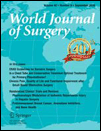Process of Pancreas Head as a Risk Factor for Postoperative Pancreatic Fistula in Laparoscopic Gastric Cancer Surgery
Nao Kobayashi, Hisashi Shinohara, and Shusuke Haruta contributed equally to this work.
Abstract
Background
Postoperative pancreatic fistula (POPF)—often caused by pancreatic injury during dissection of the peripancreatic lymph nodes—is a serious complication after gastric cancer surgery. We defined protruding pancreatic tissue on the anterior side of the pancreas head as “process of the pancreas head” (PPH) and investigated whether PPH is a predictable risk factor for POPF after laparoscopic gastrectomy.
Methods
We reviewed 255 patients who underwent laparoscopic total or distal gastrectomy for gastric cancer. The perioperative outcomes of 142 patients operated in the study’s early phase were investigated to evaluate the risk factors for POPF. To evaluate whether preoperative identification of PPH by computed tomography (CT) and intraoperative prediction of pancreas head outline could reduce the risk of POPF, the outcomes of 113 patients operated in the late phase were assessed.
Results
Of the 142 early-phase patients, PPH was identified intraoperatively in 38 patients (26.8 %). A total of 13 patients (9.1 %) developed POPF > grade 2. PPH was identified as a risk factor for POPF (P < 0.01). In early-phase patients with PPH, the POPF rate was 21.0 %; in the late phase, it decreased to 4.3 %. Further, the POPF rate in early-phase patients with BMI > 25 and PPH was 42.6 %, decreasing to 0 % in the late-phase patients.
Conclusions
The presence of PPH is a risk factor for POPF after laparoscopic gastrectomy for gastric cancer. Identifying PPH using preoperative CT images and predicting the shape of the pancreas head during infrapyloric lymph node dissection are valuable in preventing POPF following laparoscopic gastric cancer surgery.




